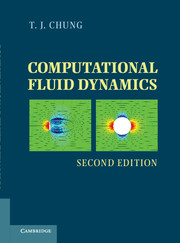Book contents
- Frontmatter
- Contents
- Preface to the First Edition
- Preface to the Revised Second Edition
- Part One Preliminaries
- Part Two Finite Difference Methods
- Part Three Finite Element Methods
- Part Four Automatic Grid Generation, Adaptive Methods, and Computing Techniques
- Part Five Applications
- Chapter Twenty-One Applications to Turbulence
- Chapter Twenty-Two Applications to Chemically Reactive Flows and Combustion
- Chapter Twenty-Three Applications to Acoustics
- Chapter Twenty-Four Applications to Combined Mode Radiative Heat Transfer
- Chapter Twenty-Five Applications to Multiphase Flows
- Chapter Twenty-Six Applications to Electromagnetic Flows
- Chapter Twenty-Seven Applications to Relativistic Astrophysical Flows
- Appendixes
- Index
- References
Chapter Twenty-Two - Applications to Chemically Reactive Flows and Combustion
from Part Five - Applications
Published online by Cambridge University Press: 05 June 2012
- Frontmatter
- Contents
- Preface to the First Edition
- Preface to the Revised Second Edition
- Part One Preliminaries
- Part Two Finite Difference Methods
- Part Three Finite Element Methods
- Part Four Automatic Grid Generation, Adaptive Methods, and Computing Techniques
- Part Five Applications
- Chapter Twenty-One Applications to Turbulence
- Chapter Twenty-Two Applications to Chemically Reactive Flows and Combustion
- Chapter Twenty-Three Applications to Acoustics
- Chapter Twenty-Four Applications to Combined Mode Radiative Heat Transfer
- Chapter Twenty-Five Applications to Multiphase Flows
- Chapter Twenty-Six Applications to Electromagnetic Flows
- Chapter Twenty-Seven Applications to Relativistic Astrophysical Flows
- Appendixes
- Index
- References
Summary
General
In this chapter, we examine computations for reactive flows in general with computational combustion in particular. In reactive flows, the conservation equations for chemical species are added to the Navier-Stokes system of equations. This addition also requires a modification of the energy equation. Furthermore, the sensible enthalpy is coupled with the chemical species, which contributes to the heat source and diffusion of species interacting with temperature. Chemical reactions in high-speed turbulent flows with high temperatures are of practical interest. They are involved in hypersonic aircraft and reentry vehicles. In this case, it is necessary that the vibrational and electronic energies be taken into account, in which the ionization of chemical species may be important. Thus, the chemically reactive flows and combustion require significant modifications of not only the governing equations but also the existing computational methods discussed in previous chapters.
In general, we are concerned with characterizing ordinary flame and detonation by different time scales. These scales range over many orders of magnitude. When reaction phenomena are modeled such that characteristic times of variation are shorter than the time step used, the equations describing such physical phenomena become numerically stiff with respect to convection and diffusion.
- Type
- Chapter
- Information
- Computational Fluid Dynamics , pp. 734 - 805Publisher: Cambridge University PressPrint publication year: 2010



